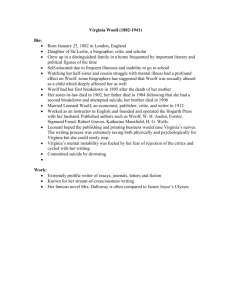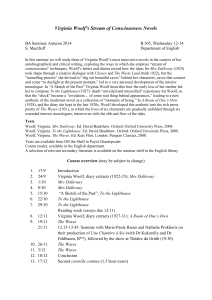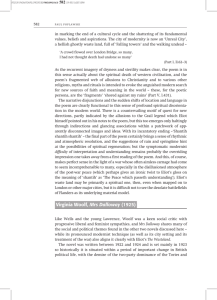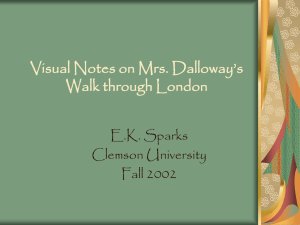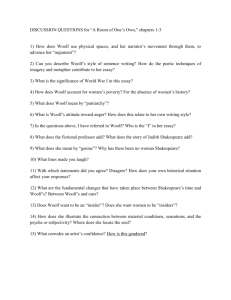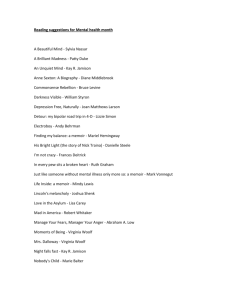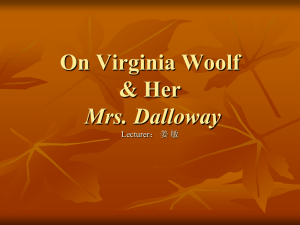Annotated Bibliography of Historical Sources
advertisement
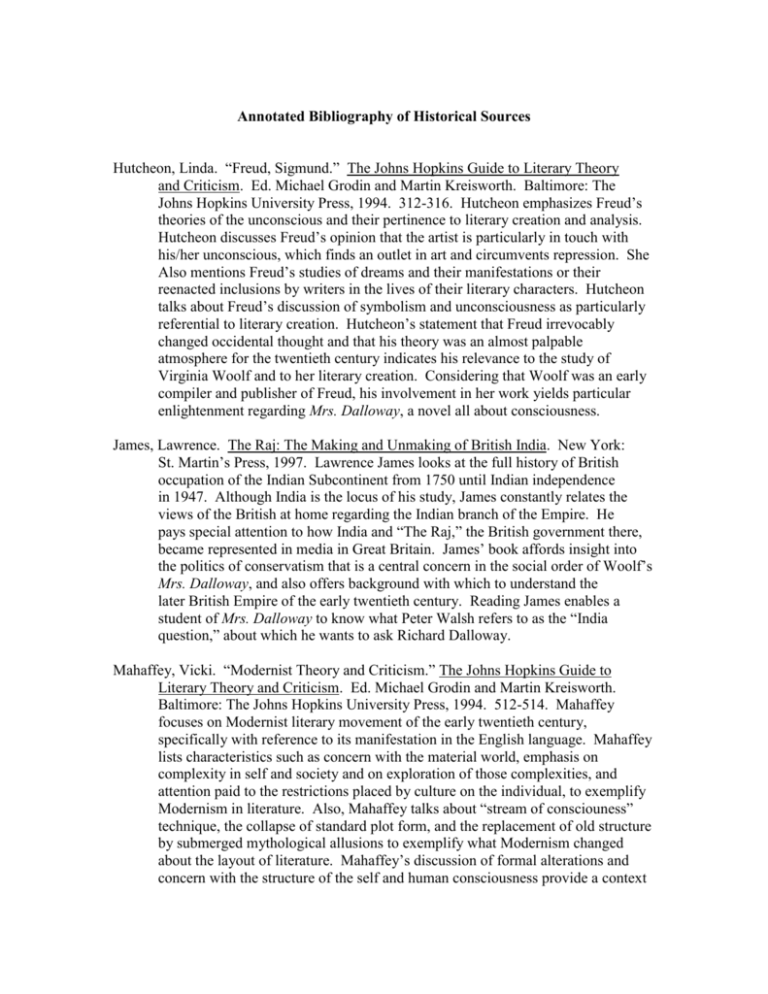
Annotated Bibliography of Historical Sources Hutcheon, Linda. “Freud, Sigmund.” The Johns Hopkins Guide to Literary Theory and Criticism. Ed. Michael Grodin and Martin Kreisworth. Baltimore: The Johns Hopkins University Press, 1994. 312-316. Hutcheon emphasizes Freud’s theories of the unconscious and their pertinence to literary creation and analysis. Hutcheon discusses Freud’s opinion that the artist is particularly in touch with his/her unconscious, which finds an outlet in art and circumvents repression. She Also mentions Freud’s studies of dreams and their manifestations or their reenacted inclusions by writers in the lives of their literary characters. Hutcheon talks about Freud’s discussion of symbolism and unconsciousness as particularly referential to literary creation. Hutcheon’s statement that Freud irrevocably changed occidental thought and that his theory was an almost palpable atmosphere for the twentieth century indicates his relevance to the study of Virginia Woolf and to her literary creation. Considering that Woolf was an early compiler and publisher of Freud, his involvement in her work yields particular enlightenment regarding Mrs. Dalloway, a novel all about consciousness. James, Lawrence. The Raj: The Making and Unmaking of British India. New York: St. Martin’s Press, 1997. Lawrence James looks at the full history of British occupation of the Indian Subcontinent from 1750 until Indian independence in 1947. Although India is the locus of his study, James constantly relates the views of the British at home regarding the Indian branch of the Empire. He pays special attention to how India and “The Raj,” the British government there, became represented in media in Great Britain. James’ book affords insight into the politics of conservatism that is a central concern in the social order of Woolf’s Mrs. Dalloway, and also offers background with which to understand the later British Empire of the early twentieth century. Reading James enables a student of Mrs. Dalloway to know what Peter Walsh refers to as the “India question,” about which he wants to ask Richard Dalloway. Mahaffey, Vicki. “Modernist Theory and Criticism.” The Johns Hopkins Guide to Literary Theory and Criticism. Ed. Michael Grodin and Martin Kreisworth. Baltimore: The Johns Hopkins University Press, 1994. 512-514. Mahaffey focuses on Modernist literary movement of the early twentieth century, specifically with reference to its manifestation in the English language. Mahaffey lists characteristics such as concern with the material world, emphasis on complexity in self and society and on exploration of those complexities, and attention paid to the restrictions placed by culture on the individual, to exemplify Modernism in literature. Also, Mahaffey talks about “stream of consciouness” technique, the collapse of standard plot form, and the replacement of old structure by submerged mythological allusions to exemplify what Modernism changed about the layout of literature. Mahaffey’s discussion of formal alterations and concern with the structure of the self and human consciousness provide a context in which to see some of the issues presented by Woolf in Mrs. Dalloway. Both that novel and Virginia Woolf are central figures of Modernism in Mahaffey’s essay. Morton, Bruce J. “Class, War and Mrs. Dalloway: Virginia Woolf’s Response to British involvement in the First World War.” Diss. Stetson U, 1996. Morton asserts that the effects of World War I which are visible in Mrs. Dalloway are unevenly distributed across the British class spectrum the book’s characters represent. He establishes the horror the war brought by casualty statistics and first-hand accounts by soldiers, and then cites class-specific statistics suggesting that the upper-class of Britain was an essential non-participant in the fighting. Much of Morton’s reading concerns a Report released by the British government in 1922 on “shell shock” and the problem of treating the mentally-wrecked war survivors. Focusing on the rhetoric of the report, Morton asserts that the British government tried to free itself of blame for the victims of the war by concealing its responsibility for them in collusion with British psychologists. Morton’s reading of the novel characterizes Hugh Whitbread, Richard Dalloway and Milly Bruton as the “intellectual aristocracy,” the hereditary governing class of the British Empire that did not feel the effects of World War I, while Septimus Smith is left to suffer mental damage and the corrupt counseling of Holmes and Bradshaw. Morton’s study is useful for its citations of statistics from World War I and its documentation of the British government’s treatment of shell-shocked soldiers, all of which amounts to a useful background against which to read the novel. Paul, James. The Victorian Heritage of Virginia Woolf. Norman, Oklahoma: Pilgrim Books, 1987. Paul James focuses on the coexistence of elements of the traditional Victorial novel and the Modernist departure from those elements that is visible in Virginia Woolf’s work. James believes Woolf fits firmly in the tradition of the English novel because she reaches backward as well as inward to compose. The Victorian characteristics James sees in Woolf’s novels include: a concern with material reality including time, place, history and tradition; an emphasis on social communion, with an attendant involvement of social mores and moral character, as necessary for defense against alienation, death and fear of self; a formal tendency to closure at conclusion of her stories; and an insistence on candid and complete communication with her readers. James sees Woolf’s material emphasis as a Victorian remnant and sees her departure from externality into concern for human consciousness as her Modernist innovation. James’ work is useful in illuminating the sources for the external and internal worlds in works like Woolf’s Mrs. Dalloway, and it is also useful in illuminating her Modernist strain as it contrasts with Victorian tradition. James’ study also excavates the society in which Virginia Woolf lived, yielding better understanding of her work.
